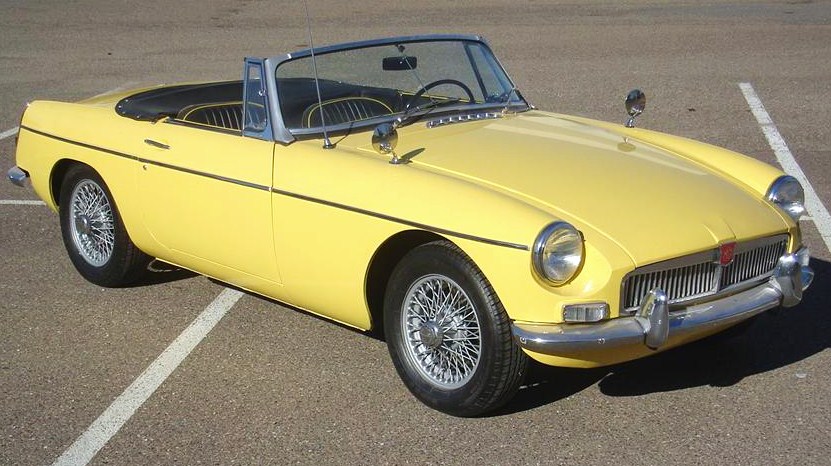
Extremely popular in its day, the MGB of Great Britain has never had great value as a collector car even though there are many thousands of owners and drivers in the U.S. who still enjoy them for what they are: fun little runabouts that look good, make the right noises and dart around curves.
Not particularly quick or sophisticated, the MGB is a sports car in true British fashion, simple and solid, emphasizing finesse rather than performance. Power is provided by a 1.8-liter four-cylinder engine that was a straightforward development of the 1.5- and 1.6-liter engines that powered its predecessor, the MGA.
MG purists cried foul when MGB first arrived with its heretical unibody construction, roomy interior and rollup windows. But the affordable MGB charmed the young people of America, and millions of them were sold.

MGB had a long production run, starting out with the 1963 model (its 50th anniversary was celebrated in September 2012) and overstaying its welcome through 1980. By then, federally mandated pollution controls had strangled the life out of its engine, and massive rubber bumpers fore and aft had damaged its looks.
Rubber-bumper Bs, which entered the scene during the 1974 model year, will always lag in value compared with the earlier chrome-bumper Bs. The MGB-GT hatchback coupes are attractive and practical but typically bring less than the roadsters.
The most desirable MGBs are the earlier ones, especially the first year, although mechanical and electrical upgrades in subsequent years made them into better cars. Most MGB people agree that the sweetest spot was the 1967 model year, when the upgrades were completed but the car was still all original before pollution and safety regulations stepped in. This was also the last gasp before the MG Car Co. was swallowed up whole by the British Leyland empire.

While the engines and drivelines are strong and easy to maintain, MGBs are prone to rust, which can weaken their unibody structures. Lucas electrical systems are notoriously problematic, particularly switches. Consistent maintenance, including chassis and front-end lubrication, is important.
Since MGBs are reasonably priced even in pristine restored condition, it’s practical to target the best ones out there, which generally top out at around $15,000-18,000. For $8,000, you can get a nice one. There are usually plenty of ratty MGBs available at cheaper prices.
Go for chrome-bumper MGBs from its first decade. Wire wheels add style and value, though they can be a hassle, and avoid the rare automatic transmission. Cars with electric overdrive added to the four-speed stickshift are definitely preferred.
There is also a six-cylinder model, the 1968-69 MGC, which is rare and fairly valuable. Nearly identical in appearance aside from a hood bulge, these are faulted for being nose heavy and offering less-agile handling, but they are praised for their increased engine power and for their long-legged highway drivability.

A small number of MGB-GTs were built in 1973-76 with V8 power using a small, lightweight Rover engine, though never officially imported to the U.S. These are rare and relatively valuable cars today. Occasionally, you come across an MGB that has been converted to V8 power, preferably with the small Rover V8. They are cool hot rods if the conversion has been done properly.
MGB parts are plentiful and inexpensive, with a number of companies carrying extensive catalogs of reproduction items ranging from camshafts to entire bodies. There’s also a great deal of club support in most areas of the country.
Nobody expects MGBs to gain tremendously in value in the near future – they’re just too plain and plentiful – though they should experience steady gains along with the collector-car market in general.
So buy one only because you like it and want to enjoy it, not as an investment.
Full disclosure: I have owned a 1970 MGB convertible for more than four decades. It was originally my daily driver. I’ve never sold it because I couldn’t see parting with it for a few thousand dollars.
In recent years, the little convertible has played second fiddle to other, more-desirable collector cars in my garage. But the MGB has been a constant. My son and daughter-in-law used it as their wedding getaway car.
In contrast to their spotty reputation, this MGB has been stone reliable and has never left me stranded. OK, once I had a flat and my spare was also deflated. But that doesn’t count.
Plus, the MGB has never failed to deliver on its promise of being totally fun to drive.





Bob: I don’t know how many people commented when this article originally was published, but MG does not stand for Morris Garages. Cecil Kimber who started the company was working at the Morris Garages and liked how the letters ‘M’ and ‘G’ sounded together so he used MG to represent his sporting versions of Morris cars and later incorporated his company as the MG Car Company. His daughter, Jean, told that story at a National MG meet a couple of decades ago. If MG really stood for Morris Garages, the company would have been incorporated as the Morris Garages Car Company.
Is the 1967 yell0w mgb pictured adove for sell? If so how much would it sell for? I am very interested in finding the best one I can for the money. Thanks so much for any information you can give me. I can use any and all information you have. Please advise me any way you can. I’m 63, a lady that needs a lot of help not being taken by just someone wanting to make a sell.